PHAR1003 Assessment Task 1: Professional Communication in Pharmacy
VerifiedAdded on 2023/04/20
|6
|1803
|165
Essay
AI Summary
This essay, written for a PHAR1003 assignment, delves into the critical role of professional communication skills in optimizing patient care within the pharmacy setting. It defines professional communication and professionalism, drawing on academic literature to establish a foundational understanding. The essay then integrates these concepts, illustrating how pharmacists can utilize effective communication to enhance patient outcomes. Key aspects discussed include the importance of clear, concise communication, adapting language to patient understanding, fostering patient-centered care through active listening and empathy, and the significance of establishing trust and building rapport. The essay emphasizes the need for pharmacists to tailor their communication to meet specific patient needs, promoting informed decision-making and adherence to treatment plans. The conclusion highlights that pharmacists need excellent communication skills to provide patients with the best possible care.
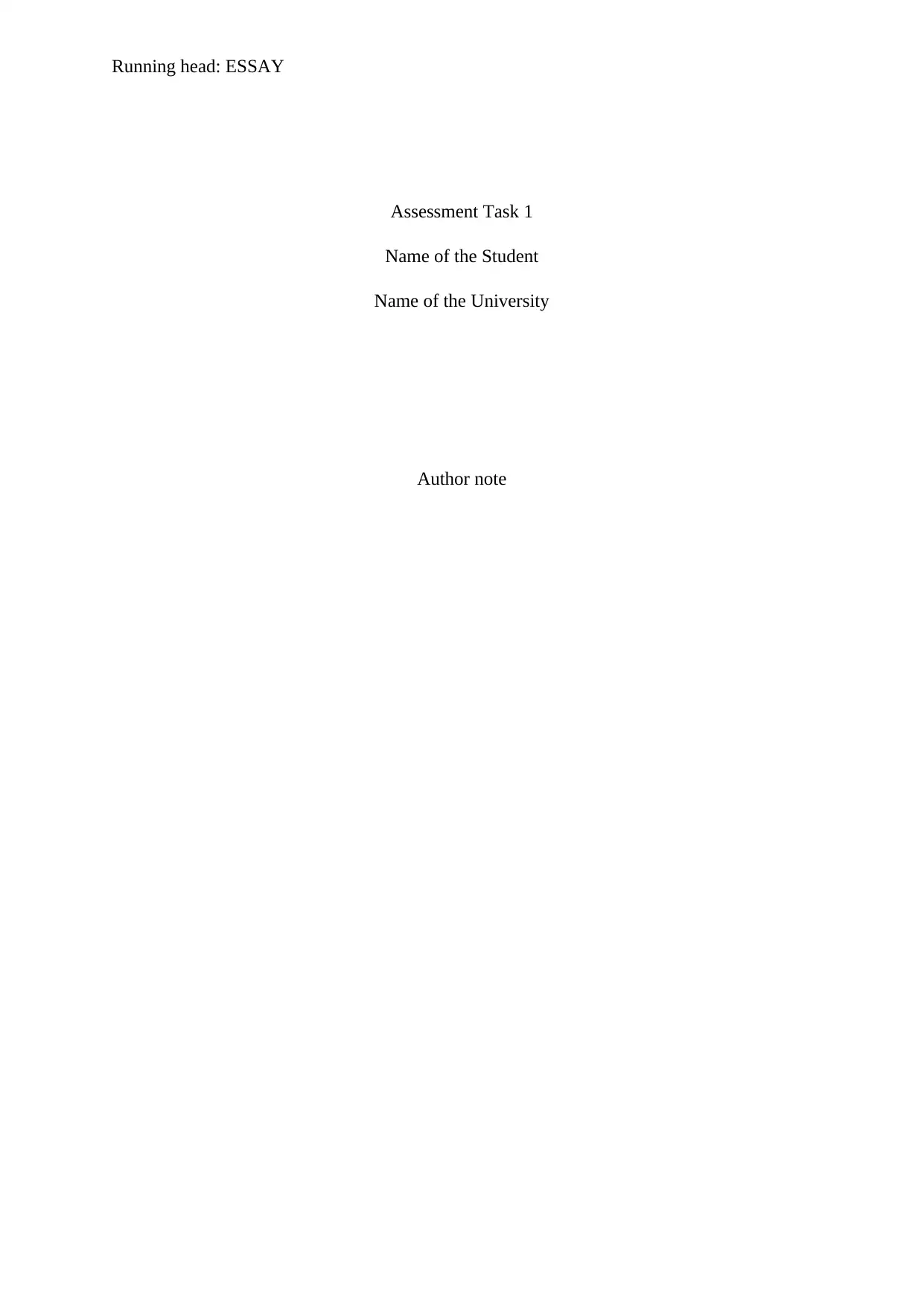
Running head: ESSAY
Assessment Task 1
Name of the Student
Name of the University
Author note
Assessment Task 1
Name of the Student
Name of the University
Author note
Paraphrase This Document
Need a fresh take? Get an instant paraphrase of this document with our AI Paraphraser
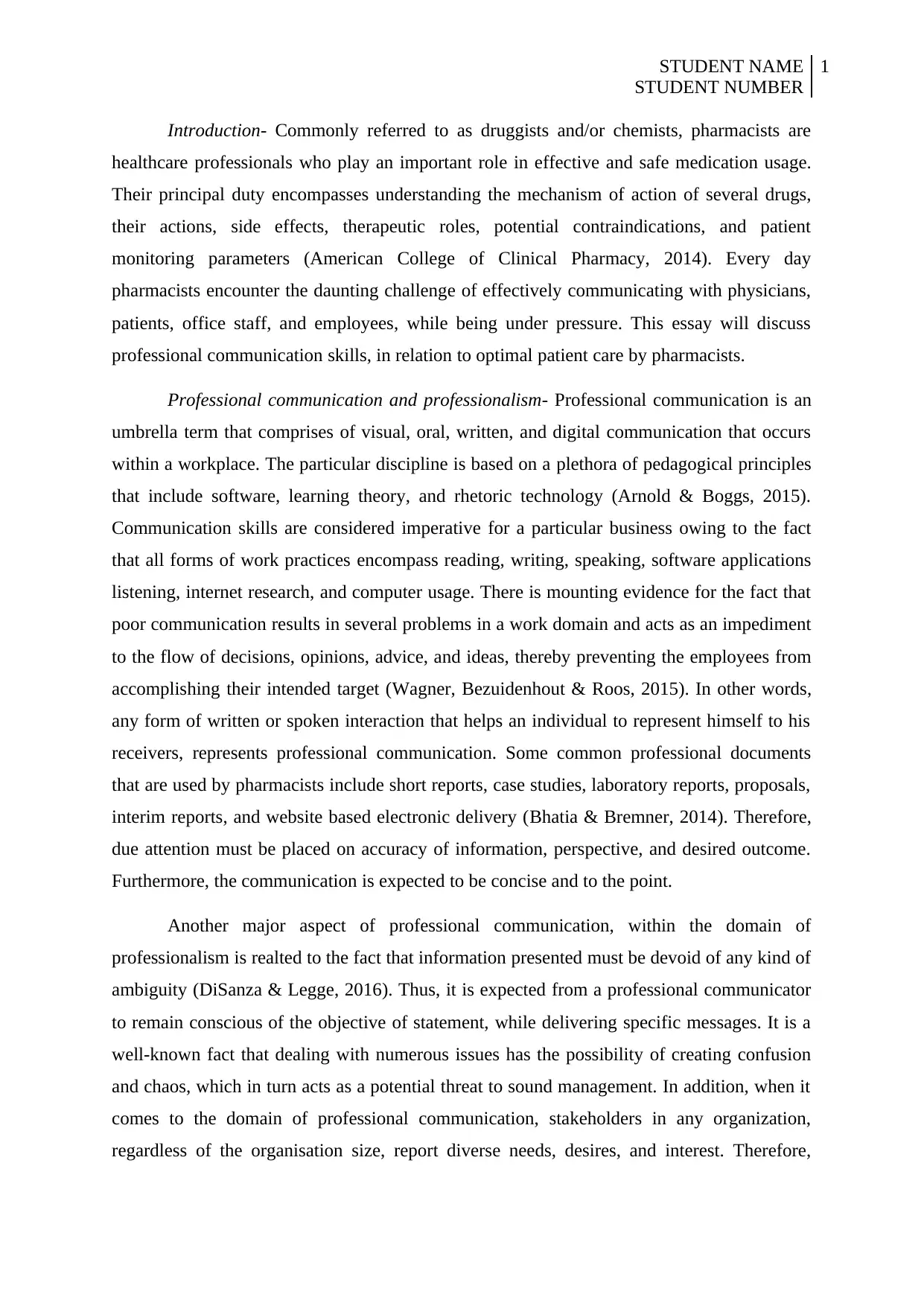
STUDENT NAME
STUDENT NUMBER
1
Introduction- Commonly referred to as druggists and/or chemists, pharmacists are
healthcare professionals who play an important role in effective and safe medication usage.
Their principal duty encompasses understanding the mechanism of action of several drugs,
their actions, side effects, therapeutic roles, potential contraindications, and patient
monitoring parameters (American College of Clinical Pharmacy, 2014). Every day
pharmacists encounter the daunting challenge of effectively communicating with physicians,
patients, office staff, and employees, while being under pressure. This essay will discuss
professional communication skills, in relation to optimal patient care by pharmacists.
Professional communication and professionalism- Professional communication is an
umbrella term that comprises of visual, oral, written, and digital communication that occurs
within a workplace. The particular discipline is based on a plethora of pedagogical principles
that include software, learning theory, and rhetoric technology (Arnold & Boggs, 2015).
Communication skills are considered imperative for a particular business owing to the fact
that all forms of work practices encompass reading, writing, speaking, software applications
listening, internet research, and computer usage. There is mounting evidence for the fact that
poor communication results in several problems in a work domain and acts as an impediment
to the flow of decisions, opinions, advice, and ideas, thereby preventing the employees from
accomplishing their intended target (Wagner, Bezuidenhout & Roos, 2015). In other words,
any form of written or spoken interaction that helps an individual to represent himself to his
receivers, represents professional communication. Some common professional documents
that are used by pharmacists include short reports, case studies, laboratory reports, proposals,
interim reports, and website based electronic delivery (Bhatia & Bremner, 2014). Therefore,
due attention must be placed on accuracy of information, perspective, and desired outcome.
Furthermore, the communication is expected to be concise and to the point.
Another major aspect of professional communication, within the domain of
professionalism is realted to the fact that information presented must be devoid of any kind of
ambiguity (DiSanza & Legge, 2016). Thus, it is expected from a professional communicator
to remain conscious of the objective of statement, while delivering specific messages. It is a
well-known fact that dealing with numerous issues has the possibility of creating confusion
and chaos, which in turn acts as a potential threat to sound management. In addition, when it
comes to the domain of professional communication, stakeholders in any organization,
regardless of the organisation size, report diverse needs, desires, and interest. Therefore,
STUDENT NUMBER
1
Introduction- Commonly referred to as druggists and/or chemists, pharmacists are
healthcare professionals who play an important role in effective and safe medication usage.
Their principal duty encompasses understanding the mechanism of action of several drugs,
their actions, side effects, therapeutic roles, potential contraindications, and patient
monitoring parameters (American College of Clinical Pharmacy, 2014). Every day
pharmacists encounter the daunting challenge of effectively communicating with physicians,
patients, office staff, and employees, while being under pressure. This essay will discuss
professional communication skills, in relation to optimal patient care by pharmacists.
Professional communication and professionalism- Professional communication is an
umbrella term that comprises of visual, oral, written, and digital communication that occurs
within a workplace. The particular discipline is based on a plethora of pedagogical principles
that include software, learning theory, and rhetoric technology (Arnold & Boggs, 2015).
Communication skills are considered imperative for a particular business owing to the fact
that all forms of work practices encompass reading, writing, speaking, software applications
listening, internet research, and computer usage. There is mounting evidence for the fact that
poor communication results in several problems in a work domain and acts as an impediment
to the flow of decisions, opinions, advice, and ideas, thereby preventing the employees from
accomplishing their intended target (Wagner, Bezuidenhout & Roos, 2015). In other words,
any form of written or spoken interaction that helps an individual to represent himself to his
receivers, represents professional communication. Some common professional documents
that are used by pharmacists include short reports, case studies, laboratory reports, proposals,
interim reports, and website based electronic delivery (Bhatia & Bremner, 2014). Therefore,
due attention must be placed on accuracy of information, perspective, and desired outcome.
Furthermore, the communication is expected to be concise and to the point.
Another major aspect of professional communication, within the domain of
professionalism is realted to the fact that information presented must be devoid of any kind of
ambiguity (DiSanza & Legge, 2016). Thus, it is expected from a professional communicator
to remain conscious of the objective of statement, while delivering specific messages. It is a
well-known fact that dealing with numerous issues has the possibility of creating confusion
and chaos, which in turn acts as a potential threat to sound management. In addition, when it
comes to the domain of professional communication, stakeholders in any organization,
regardless of the organisation size, report diverse needs, desires, and interest. Therefore,
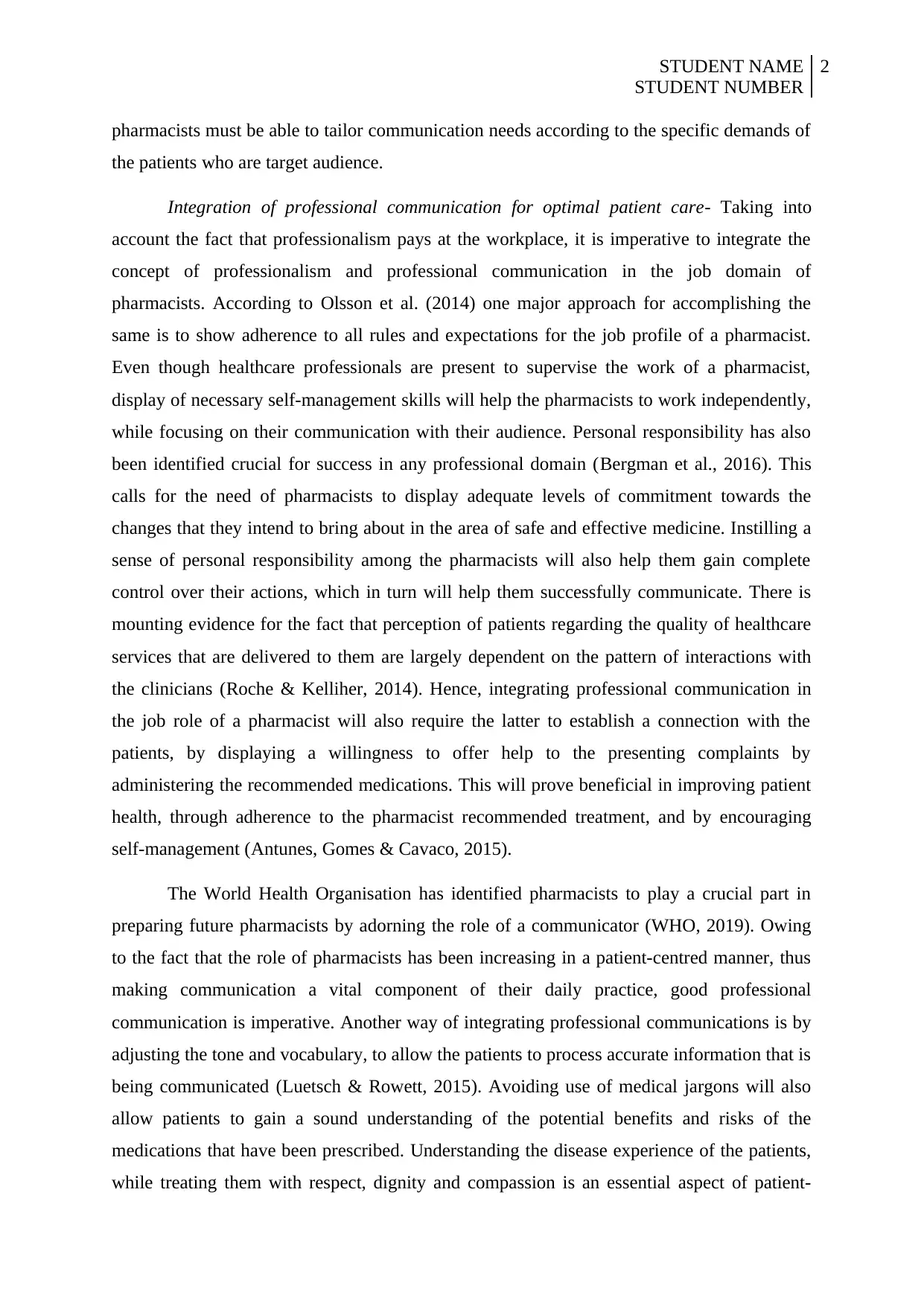
STUDENT NAME
STUDENT NUMBER
2
pharmacists must be able to tailor communication needs according to the specific demands of
the patients who are target audience.
Integration of professional communication for optimal patient care- Taking into
account the fact that professionalism pays at the workplace, it is imperative to integrate the
concept of professionalism and professional communication in the job domain of
pharmacists. According to Olsson et al. (2014) one major approach for accomplishing the
same is to show adherence to all rules and expectations for the job profile of a pharmacist.
Even though healthcare professionals are present to supervise the work of a pharmacist,
display of necessary self-management skills will help the pharmacists to work independently,
while focusing on their communication with their audience. Personal responsibility has also
been identified crucial for success in any professional domain (Bergman et al., 2016). This
calls for the need of pharmacists to display adequate levels of commitment towards the
changes that they intend to bring about in the area of safe and effective medicine. Instilling a
sense of personal responsibility among the pharmacists will also help them gain complete
control over their actions, which in turn will help them successfully communicate. There is
mounting evidence for the fact that perception of patients regarding the quality of healthcare
services that are delivered to them are largely dependent on the pattern of interactions with
the clinicians (Roche & Kelliher, 2014). Hence, integrating professional communication in
the job role of a pharmacist will also require the latter to establish a connection with the
patients, by displaying a willingness to offer help to the presenting complaints by
administering the recommended medications. This will prove beneficial in improving patient
health, through adherence to the pharmacist recommended treatment, and by encouraging
self-management (Antunes, Gomes & Cavaco, 2015).
The World Health Organisation has identified pharmacists to play a crucial part in
preparing future pharmacists by adorning the role of a communicator (WHO, 2019). Owing
to the fact that the role of pharmacists has been increasing in a patient-centred manner, thus
making communication a vital component of their daily practice, good professional
communication is imperative. Another way of integrating professional communications is by
adjusting the tone and vocabulary, to allow the patients to process accurate information that is
being communicated (Luetsch & Rowett, 2015). Avoiding use of medical jargons will also
allow patients to gain a sound understanding of the potential benefits and risks of the
medications that have been prescribed. Understanding the disease experience of the patients,
while treating them with respect, dignity and compassion is an essential aspect of patient-
STUDENT NUMBER
2
pharmacists must be able to tailor communication needs according to the specific demands of
the patients who are target audience.
Integration of professional communication for optimal patient care- Taking into
account the fact that professionalism pays at the workplace, it is imperative to integrate the
concept of professionalism and professional communication in the job domain of
pharmacists. According to Olsson et al. (2014) one major approach for accomplishing the
same is to show adherence to all rules and expectations for the job profile of a pharmacist.
Even though healthcare professionals are present to supervise the work of a pharmacist,
display of necessary self-management skills will help the pharmacists to work independently,
while focusing on their communication with their audience. Personal responsibility has also
been identified crucial for success in any professional domain (Bergman et al., 2016). This
calls for the need of pharmacists to display adequate levels of commitment towards the
changes that they intend to bring about in the area of safe and effective medicine. Instilling a
sense of personal responsibility among the pharmacists will also help them gain complete
control over their actions, which in turn will help them successfully communicate. There is
mounting evidence for the fact that perception of patients regarding the quality of healthcare
services that are delivered to them are largely dependent on the pattern of interactions with
the clinicians (Roche & Kelliher, 2014). Hence, integrating professional communication in
the job role of a pharmacist will also require the latter to establish a connection with the
patients, by displaying a willingness to offer help to the presenting complaints by
administering the recommended medications. This will prove beneficial in improving patient
health, through adherence to the pharmacist recommended treatment, and by encouraging
self-management (Antunes, Gomes & Cavaco, 2015).
The World Health Organisation has identified pharmacists to play a crucial part in
preparing future pharmacists by adorning the role of a communicator (WHO, 2019). Owing
to the fact that the role of pharmacists has been increasing in a patient-centred manner, thus
making communication a vital component of their daily practice, good professional
communication is imperative. Another way of integrating professional communications is by
adjusting the tone and vocabulary, to allow the patients to process accurate information that is
being communicated (Luetsch & Rowett, 2015). Avoiding use of medical jargons will also
allow patients to gain a sound understanding of the potential benefits and risks of the
medications that have been prescribed. Understanding the disease experience of the patients,
while treating them with respect, dignity and compassion is an essential aspect of patient-
⊘ This is a preview!⊘
Do you want full access?
Subscribe today to unlock all pages.

Trusted by 1+ million students worldwide
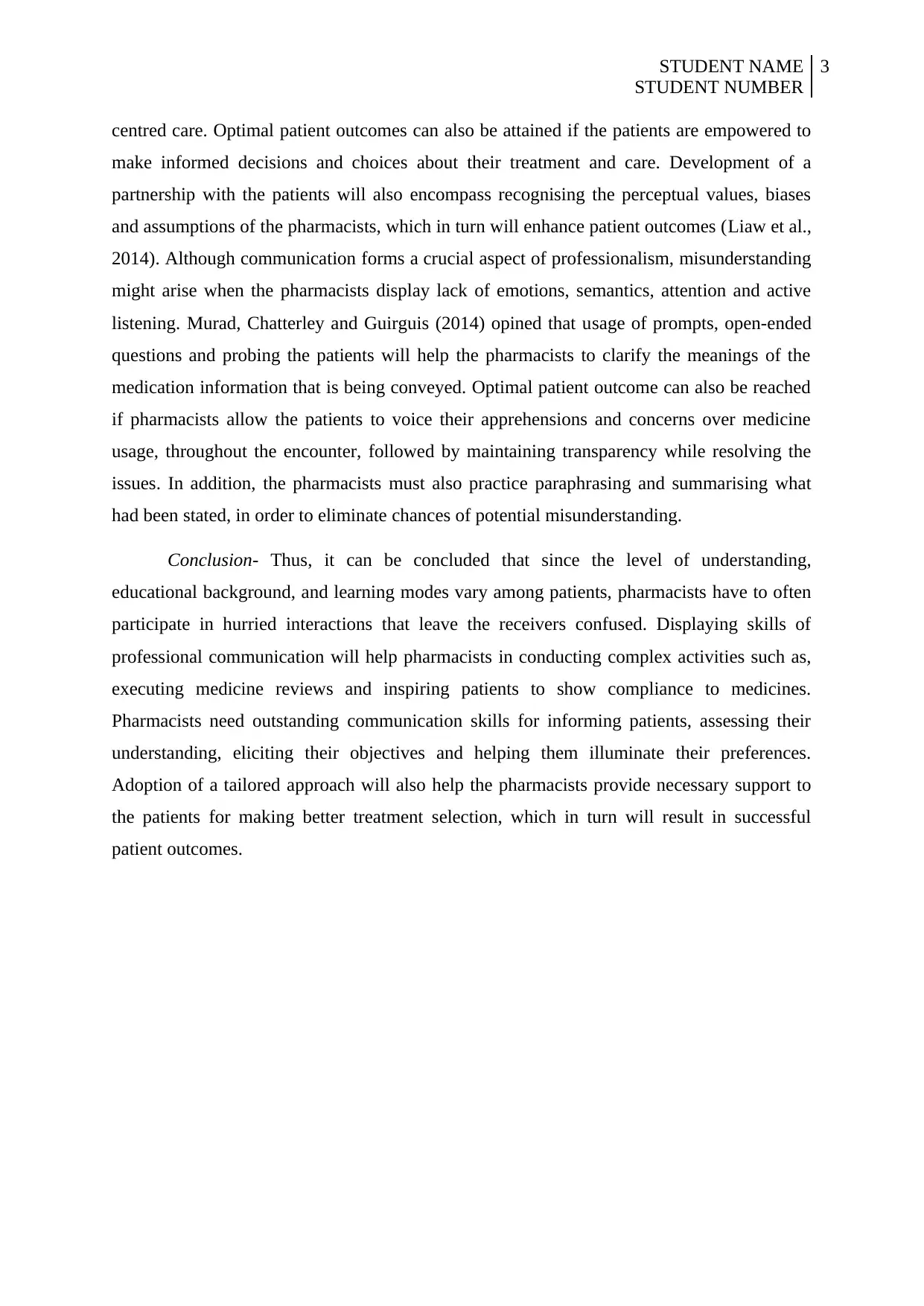
STUDENT NAME
STUDENT NUMBER
3
centred care. Optimal patient outcomes can also be attained if the patients are empowered to
make informed decisions and choices about their treatment and care. Development of a
partnership with the patients will also encompass recognising the perceptual values, biases
and assumptions of the pharmacists, which in turn will enhance patient outcomes (Liaw et al.,
2014). Although communication forms a crucial aspect of professionalism, misunderstanding
might arise when the pharmacists display lack of emotions, semantics, attention and active
listening. Murad, Chatterley and Guirguis (2014) opined that usage of prompts, open-ended
questions and probing the patients will help the pharmacists to clarify the meanings of the
medication information that is being conveyed. Optimal patient outcome can also be reached
if pharmacists allow the patients to voice their apprehensions and concerns over medicine
usage, throughout the encounter, followed by maintaining transparency while resolving the
issues. In addition, the pharmacists must also practice paraphrasing and summarising what
had been stated, in order to eliminate chances of potential misunderstanding.
Conclusion- Thus, it can be concluded that since the level of understanding,
educational background, and learning modes vary among patients, pharmacists have to often
participate in hurried interactions that leave the receivers confused. Displaying skills of
professional communication will help pharmacists in conducting complex activities such as,
executing medicine reviews and inspiring patients to show compliance to medicines.
Pharmacists need outstanding communication skills for informing patients, assessing their
understanding, eliciting their objectives and helping them illuminate their preferences.
Adoption of a tailored approach will also help the pharmacists provide necessary support to
the patients for making better treatment selection, which in turn will result in successful
patient outcomes.
STUDENT NUMBER
3
centred care. Optimal patient outcomes can also be attained if the patients are empowered to
make informed decisions and choices about their treatment and care. Development of a
partnership with the patients will also encompass recognising the perceptual values, biases
and assumptions of the pharmacists, which in turn will enhance patient outcomes (Liaw et al.,
2014). Although communication forms a crucial aspect of professionalism, misunderstanding
might arise when the pharmacists display lack of emotions, semantics, attention and active
listening. Murad, Chatterley and Guirguis (2014) opined that usage of prompts, open-ended
questions and probing the patients will help the pharmacists to clarify the meanings of the
medication information that is being conveyed. Optimal patient outcome can also be reached
if pharmacists allow the patients to voice their apprehensions and concerns over medicine
usage, throughout the encounter, followed by maintaining transparency while resolving the
issues. In addition, the pharmacists must also practice paraphrasing and summarising what
had been stated, in order to eliminate chances of potential misunderstanding.
Conclusion- Thus, it can be concluded that since the level of understanding,
educational background, and learning modes vary among patients, pharmacists have to often
participate in hurried interactions that leave the receivers confused. Displaying skills of
professional communication will help pharmacists in conducting complex activities such as,
executing medicine reviews and inspiring patients to show compliance to medicines.
Pharmacists need outstanding communication skills for informing patients, assessing their
understanding, eliciting their objectives and helping them illuminate their preferences.
Adoption of a tailored approach will also help the pharmacists provide necessary support to
the patients for making better treatment selection, which in turn will result in successful
patient outcomes.
Paraphrase This Document
Need a fresh take? Get an instant paraphrase of this document with our AI Paraphraser
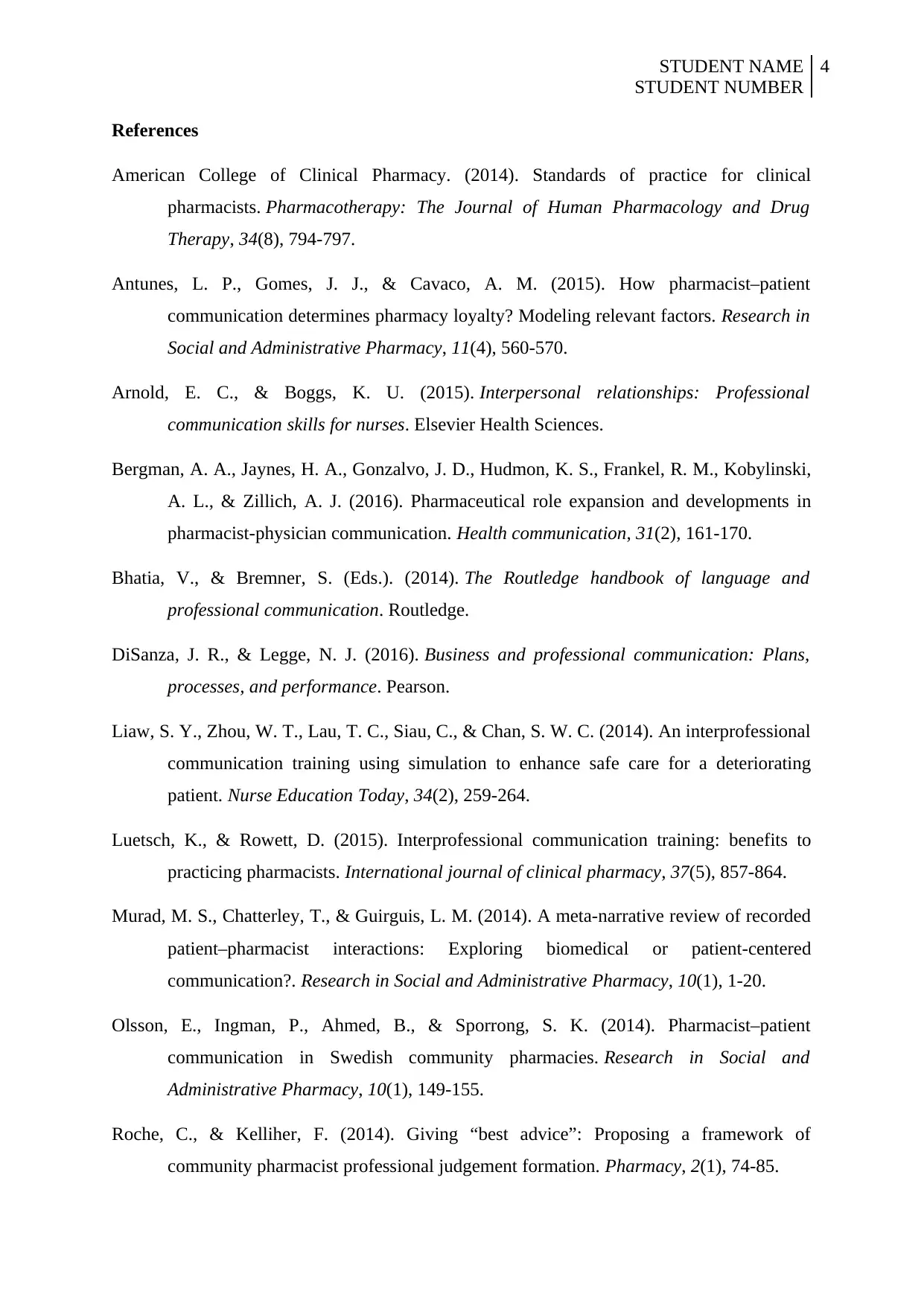
STUDENT NAME
STUDENT NUMBER
4
References
American College of Clinical Pharmacy. (2014). Standards of practice for clinical
pharmacists. Pharmacotherapy: The Journal of Human Pharmacology and Drug
Therapy, 34(8), 794-797.
Antunes, L. P., Gomes, J. J., & Cavaco, A. M. (2015). How pharmacist–patient
communication determines pharmacy loyalty? Modeling relevant factors. Research in
Social and Administrative Pharmacy, 11(4), 560-570.
Arnold, E. C., & Boggs, K. U. (2015). Interpersonal relationships: Professional
communication skills for nurses. Elsevier Health Sciences.
Bergman, A. A., Jaynes, H. A., Gonzalvo, J. D., Hudmon, K. S., Frankel, R. M., Kobylinski,
A. L., & Zillich, A. J. (2016). Pharmaceutical role expansion and developments in
pharmacist-physician communication. Health communication, 31(2), 161-170.
Bhatia, V., & Bremner, S. (Eds.). (2014). The Routledge handbook of language and
professional communication. Routledge.
DiSanza, J. R., & Legge, N. J. (2016). Business and professional communication: Plans,
processes, and performance. Pearson.
Liaw, S. Y., Zhou, W. T., Lau, T. C., Siau, C., & Chan, S. W. C. (2014). An interprofessional
communication training using simulation to enhance safe care for a deteriorating
patient. Nurse Education Today, 34(2), 259-264.
Luetsch, K., & Rowett, D. (2015). Interprofessional communication training: benefits to
practicing pharmacists. International journal of clinical pharmacy, 37(5), 857-864.
Murad, M. S., Chatterley, T., & Guirguis, L. M. (2014). A meta-narrative review of recorded
patient–pharmacist interactions: Exploring biomedical or patient-centered
communication?. Research in Social and Administrative Pharmacy, 10(1), 1-20.
Olsson, E., Ingman, P., Ahmed, B., & Sporrong, S. K. (2014). Pharmacist–patient
communication in Swedish community pharmacies. Research in Social and
Administrative Pharmacy, 10(1), 149-155.
Roche, C., & Kelliher, F. (2014). Giving “best advice”: Proposing a framework of
community pharmacist professional judgement formation. Pharmacy, 2(1), 74-85.
STUDENT NUMBER
4
References
American College of Clinical Pharmacy. (2014). Standards of practice for clinical
pharmacists. Pharmacotherapy: The Journal of Human Pharmacology and Drug
Therapy, 34(8), 794-797.
Antunes, L. P., Gomes, J. J., & Cavaco, A. M. (2015). How pharmacist–patient
communication determines pharmacy loyalty? Modeling relevant factors. Research in
Social and Administrative Pharmacy, 11(4), 560-570.
Arnold, E. C., & Boggs, K. U. (2015). Interpersonal relationships: Professional
communication skills for nurses. Elsevier Health Sciences.
Bergman, A. A., Jaynes, H. A., Gonzalvo, J. D., Hudmon, K. S., Frankel, R. M., Kobylinski,
A. L., & Zillich, A. J. (2016). Pharmaceutical role expansion and developments in
pharmacist-physician communication. Health communication, 31(2), 161-170.
Bhatia, V., & Bremner, S. (Eds.). (2014). The Routledge handbook of language and
professional communication. Routledge.
DiSanza, J. R., & Legge, N. J. (2016). Business and professional communication: Plans,
processes, and performance. Pearson.
Liaw, S. Y., Zhou, W. T., Lau, T. C., Siau, C., & Chan, S. W. C. (2014). An interprofessional
communication training using simulation to enhance safe care for a deteriorating
patient. Nurse Education Today, 34(2), 259-264.
Luetsch, K., & Rowett, D. (2015). Interprofessional communication training: benefits to
practicing pharmacists. International journal of clinical pharmacy, 37(5), 857-864.
Murad, M. S., Chatterley, T., & Guirguis, L. M. (2014). A meta-narrative review of recorded
patient–pharmacist interactions: Exploring biomedical or patient-centered
communication?. Research in Social and Administrative Pharmacy, 10(1), 1-20.
Olsson, E., Ingman, P., Ahmed, B., & Sporrong, S. K. (2014). Pharmacist–patient
communication in Swedish community pharmacies. Research in Social and
Administrative Pharmacy, 10(1), 149-155.
Roche, C., & Kelliher, F. (2014). Giving “best advice”: Proposing a framework of
community pharmacist professional judgement formation. Pharmacy, 2(1), 74-85.
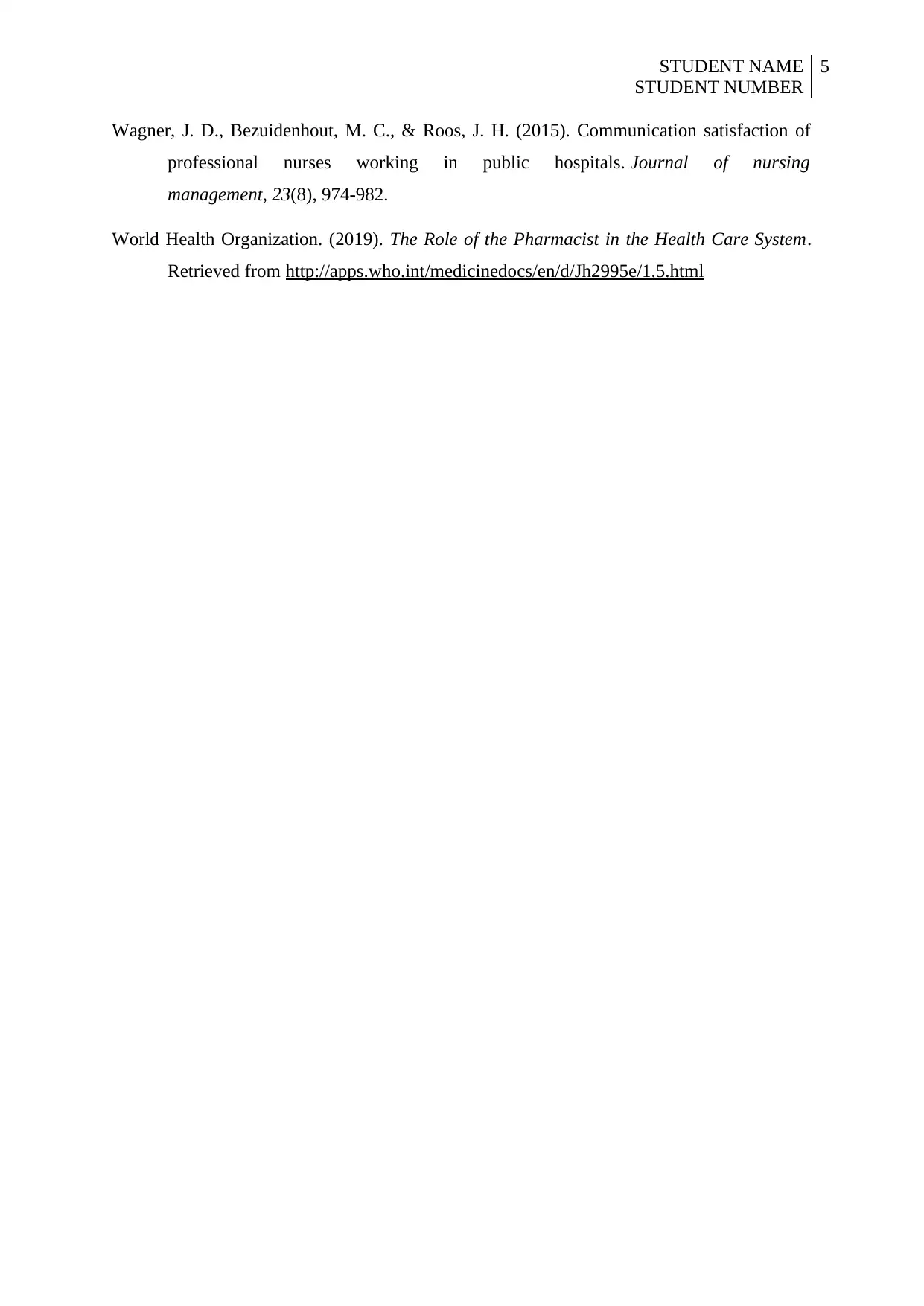
STUDENT NAME
STUDENT NUMBER
5
Wagner, J. D., Bezuidenhout, M. C., & Roos, J. H. (2015). Communication satisfaction of
professional nurses working in public hospitals. Journal of nursing
management, 23(8), 974-982.
World Health Organization. (2019). The Role of the Pharmacist in the Health Care System.
Retrieved from http://apps.who.int/medicinedocs/en/d/Jh2995e/1.5.html
STUDENT NUMBER
5
Wagner, J. D., Bezuidenhout, M. C., & Roos, J. H. (2015). Communication satisfaction of
professional nurses working in public hospitals. Journal of nursing
management, 23(8), 974-982.
World Health Organization. (2019). The Role of the Pharmacist in the Health Care System.
Retrieved from http://apps.who.int/medicinedocs/en/d/Jh2995e/1.5.html
⊘ This is a preview!⊘
Do you want full access?
Subscribe today to unlock all pages.

Trusted by 1+ million students worldwide
1 out of 6
Related Documents
Your All-in-One AI-Powered Toolkit for Academic Success.
+13062052269
info@desklib.com
Available 24*7 on WhatsApp / Email
![[object Object]](/_next/static/media/star-bottom.7253800d.svg)
Unlock your academic potential
Copyright © 2020–2025 A2Z Services. All Rights Reserved. Developed and managed by ZUCOL.





